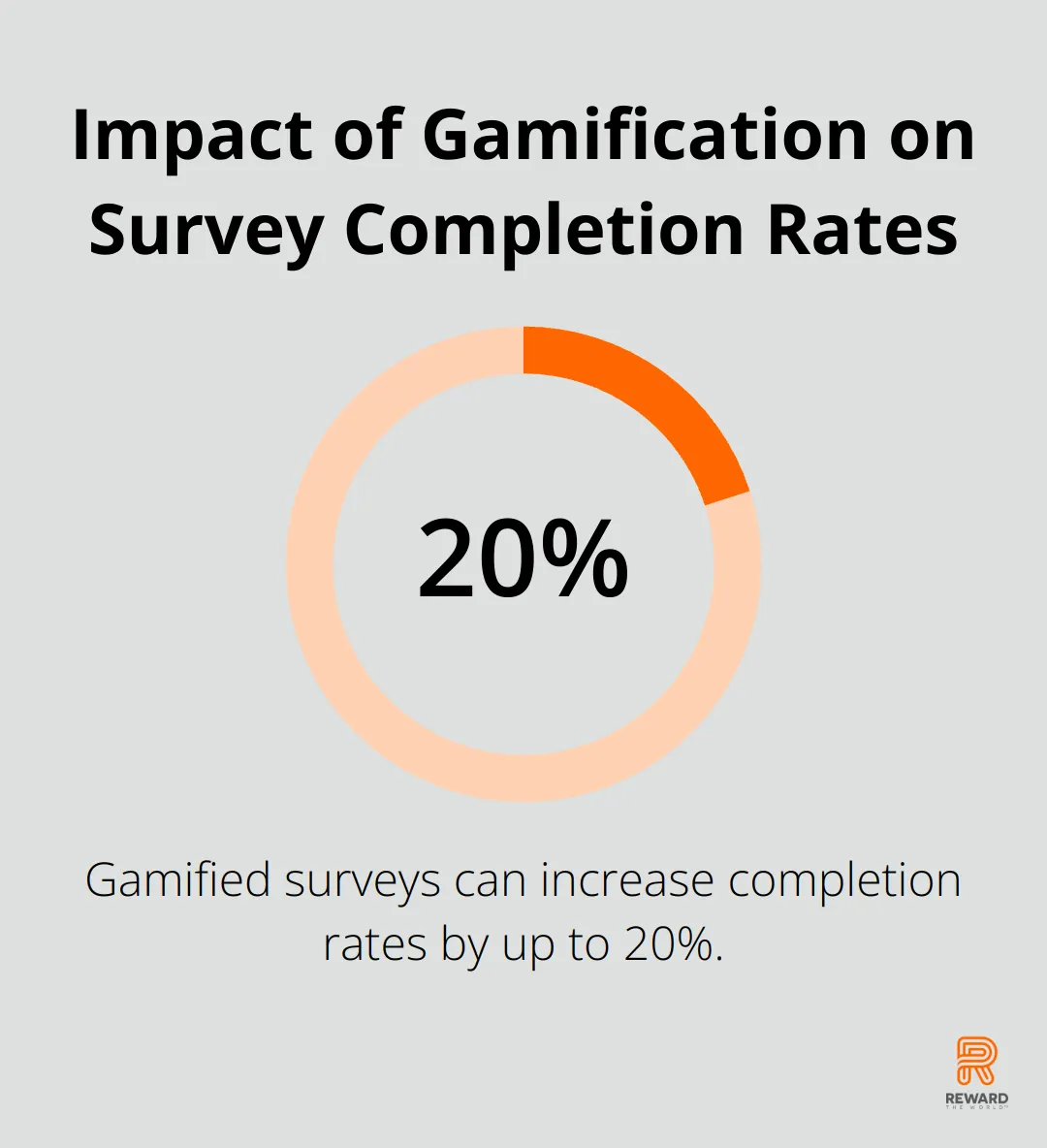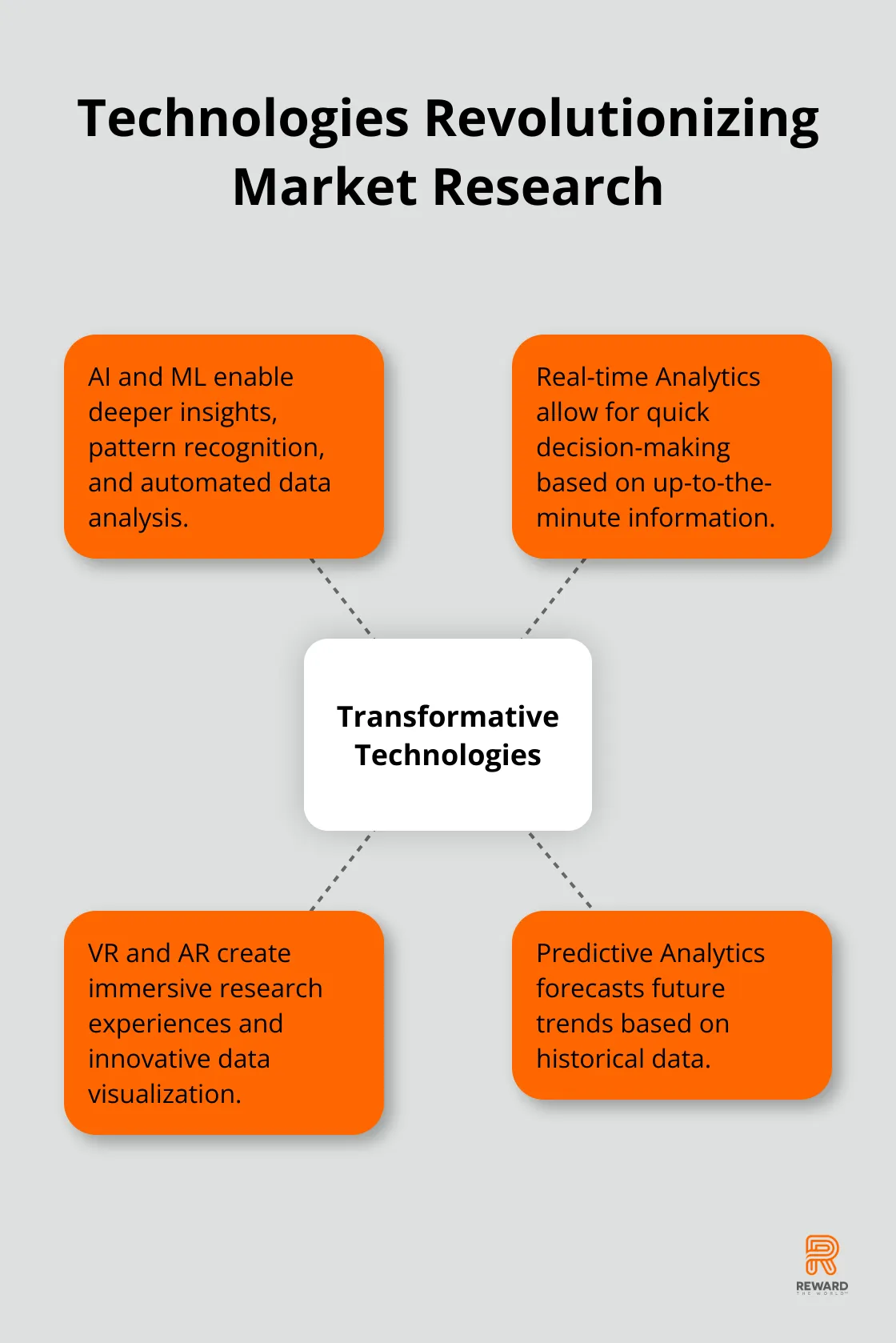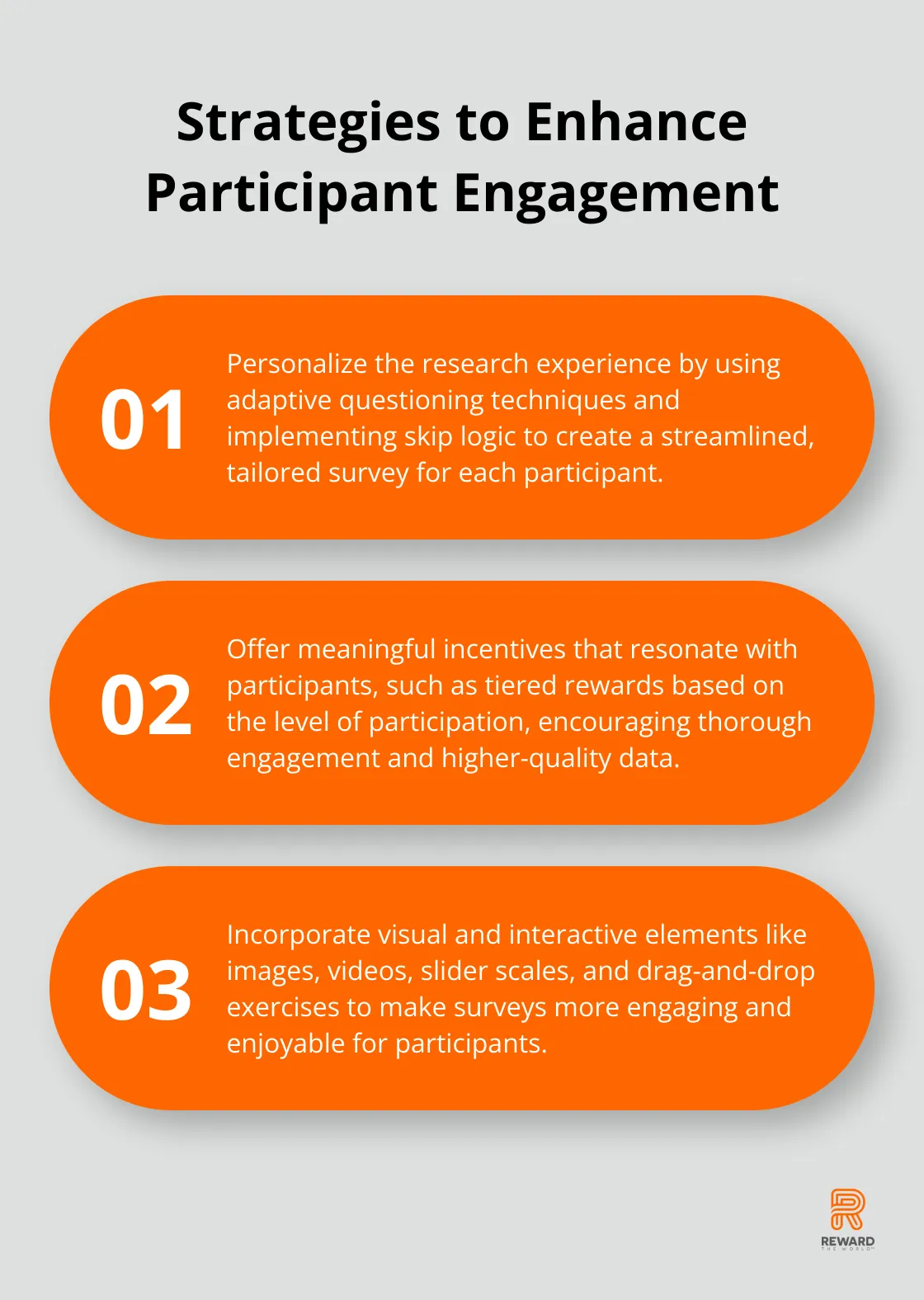
Market research is evolving rapidly, and at Reward the World, we’re always looking for ways to keep it fresh and engaging. With survey fatigue becoming a growing concern, it’s crucial to adopt innovative approaches that captivate participants and yield valuable insights.
This blog post explores cutting-edge methods and technologies that can revolutionize your market research efforts. From leveraging social media listening tools to implementing gamification in surveys, we’ll show you how to stay ahead of the curve and gather more meaningful data.
Innovative Data Collection Methods
Market research is rapidly evolving, and innovative data collection methods are at the forefront of this transformation. These cutting-edge techniques revolutionize how we gather insights, offering deeper, more authentic data that traditional methods often miss.
Social Media Listening: Real-Time Consumer Insights
Social media platforms serve as goldmines for unfiltered consumer opinions. Advanced social listening tools allow researchers to track conversations related to your brand, analyze sentiment, and identify emerging topics across multiple platforms. This real-time data provides a comprehensive look into consumer attitudes that traditional surveys often fail to capture.
Mobile Ethnography: A Glimpse into Consumer Lives
Mobile ethnography uses smartphones to gather in-the-moment insights about consumer behavior. Participants document their experiences through photos, videos, and voice notes as they go about their daily lives. This method offers a more natural and less intrusive way to understand consumer habits compared to traditional observation techniques. EthOs is a qualitative research platform that allows users to capture insights and data from omnichannel touchpoints to provide insights on consumer behavior.
Gamification: Surveys That Engage and Entertain
Traditional surveys often bore participants. Gamification injects fun and interactivity into the research process, boosting participation rates and data quality. Elements like points, leaderboards, and rewards transform mundane questionnaires into engaging experiences. A study by the Market Research Society found that gamified surveys can increase completion rates by up to 20%. Platforms like Qualtrics offer built-in gamification features that simplify this approach.

Virtual Reality (VR) and Augmented Reality (AR): Immersive Research Experiences
VR and AR technologies open up new possibilities for market research. These immersive tools allow researchers to create realistic simulations of products or environments, enabling participants to interact with concepts in a more tangible way. This approach proves particularly valuable for testing product designs, store layouts, or user experiences before physical implementation.
AI-Powered Chatbots: Conversational Data Collection
AI-powered chatbots represent a significant leap forward in survey methodology. These intelligent conversational agents can conduct interviews, ask follow-up questions based on responses, and even detect emotional cues. This approach not only makes the survey process more engaging for participants but also allows for the collection of more nuanced and contextual data.
As we explore these innovative data collection methods, it becomes clear that the future of market research lies in embracing technology and creativity. The next section will delve into how we can leverage these advanced techniques to analyze and visualize the wealth of data they produce.
How AI and Real-Time Analytics Transform Market Research
In the fast-paced world of market research, cutting-edge technology has become essential. Artificial intelligence (AI), machine learning (ML), and real-time analytics reshape how we analyze and interpret data. This chapter explores these technologies’ impact on market research and how you can use them for deeper, more actionable insights.
AI and Machine Learning: Revolutionizing Data Analysis
AI and machine learning are revolutionising market research, enabling deeper insights, predictive analytics, and personalised strategies to drive business. These technologies identify patterns and trends that human analysts might overlook, providing a more comprehensive understanding of consumer behavior.

Sentiment analysis powered by AI sifts through millions of social media posts, reviews, and comments to gauge public opinion about a brand or product. This approach offers a more nuanced view of consumer sentiment compared to traditional surveys.
Predictive analytics, a subset of AI, forecasts future trends based on historical data. This capability proves invaluable for businesses looking to stay ahead of market shifts.
Real-Time Data Analytics: Making Informed Decisions Quickly
In today’s market, waiting weeks or months for research results is no longer viable. Real-time data analytics allows businesses to make informed decisions quickly, based on up-to-the-minute information.
Marketing analytics tools include web analytics platforms like Google Analytics and social media analytics tools such as Hootsuite. These tools offer real-time insights into website traffic, user behavior, and conversion rates. This immediate feedback enables marketers to adjust their strategies on the fly, optimizing campaigns for maximum impact.
Real-time analytics applies to social media monitoring, allowing brands to respond promptly to customer feedback or emerging trends. This agility can provide a significant competitive advantage in crowded markets.
VR and AR: Transforming Data Visualization
Virtual Reality (VR) and Augmented Reality (AR) are changing market research by providing innovative ways to understand consumer behavior, preferences, and insights. These technologies transform complex datasets into immersive, interactive experiences that make insights more accessible and engaging.
VR creates virtual store environments where researchers observe consumer behavior in a controlled setting. AR overlays data onto real-world objects, providing context-rich insights that are difficult to achieve with traditional methods.
While still in its early stages, VR and AR in market research show enormous potential for providing innovative ways to understand consumer behavior and preferences.
The Future of Market Research Technology
As technology continues to advance, we can expect even more innovative tools and methods to emerge in the field of market research. From AI-powered chatbots conducting interviews to blockchain ensuring data integrity, the possibilities are endless.
These technological advancements in market research analysis provide a significant edge in understanding consumer behavior and market trends. The insights gained become increasingly valuable, driving more informed business decisions and strategies.
The next chapter will explore how these advanced technologies can enhance participant engagement in market research studies, creating more meaningful and interactive experiences for respondents.
How to Boost Participant Engagement in Market Research
Engaging participants in market research is essential for obtaining high-quality data. At Reward the World, we’ve observed how enhanced engagement leads to more accurate and insightful results. This chapter explores proven strategies to boost participant engagement in your market research efforts.

Personalize the Research Experience
Personalization extends beyond addressing participants by name. Utilizing multiple channels, such as social media, websites, SMS, and in-app notifications, can help reach a broader audience and increase participation rates. This approach involves tailoring the research experience to individual preferences and behaviors. Use adaptive questioning techniques that adjust based on previous responses. This approach reduces irrelevant questions and keeps participants engaged throughout the survey.
Implement skip logic to create a more streamlined experience. For example, if a participant indicates they don’t own a car, automatically skip questions about car maintenance. This personalized approach can help you see if visitors are interested in your products and pitch the correct sales information.
Offer Meaningful Incentives
While offering incentives is common practice, the key is to provide rewards that truly resonate with your participants. Consider tiered incentives based on the level of participation. Offer a base reward for completing a survey and additional bonuses for providing detailed responses or participating in follow-up interviews. This approach encourages thorough engagement and higher-quality data.
Incorporate Visual and Interactive Elements
Transform your surveys from text-heavy questionnaires into engaging visual experiences. Add images, videos, and interactive elements to maintain interest and improve comprehension.
Use slider scales instead of traditional radio buttons for rating questions. Implement drag-and-drop ranking exercises for more engaging prioritization tasks. These interactive elements not only make the survey more enjoyable but can also yield more accurate results.
Consider using heat mapping questions for visual feedback on images or product designs.
Prioritize Mobile-First Design
With over 50% of internet traffic coming from mobile devices, ensuring your research is mobile-friendly is a must. Design your surveys with a mobile-first approach, using large touch-friendly buttons and minimizing the need for text input.
Add progress bars to show participants how far along they are in the survey. This simple addition can increase completion rates by giving participants a clear sense of how much time is left.
Gamify the Research Process
Add game-like elements to your research to make participation more enjoyable. Use point systems, leaderboards, or achievement badges to motivate participants. For example, award points for each completed section and display a leaderboard showing top contributors.
Gamified surveys can increase response quality. A study analyzing 114 articles provides a hybrid review integrating bibliometric and TCCM analysis of gamification in marketing. However, ensure that gamification elements don’t distract from the primary research objectives.
Final Thoughts
The market research landscape has transformed with innovative data collection methods and cutting-edge analysis techniques. Social media listening tools, mobile ethnography, and gamification combat survey fatigue while yielding richer insights. AI, machine learning, and real-time analytics enable deeper data interpretation and faster decision-making, while VR and AR open exciting possibilities for immersive research experiences.
Personalization, meaningful incentives, and interactive survey designs prove essential for high-quality data collection. Mobile-first design and gamification elements create research experiences that resonate with participants and yield more accurate results. Businesses that adapt to these trends will gain a competitive edge in gathering meaningful insights that drive success.
We at Reward the World push the boundaries of market research with our global incentives platform. Our turnkey solution boosts engagement and gathers valuable insights through instant reward delivery and diverse options. As the field evolves, continuous innovation in research methods will remain key to understanding and shaping the dynamic business landscape.
